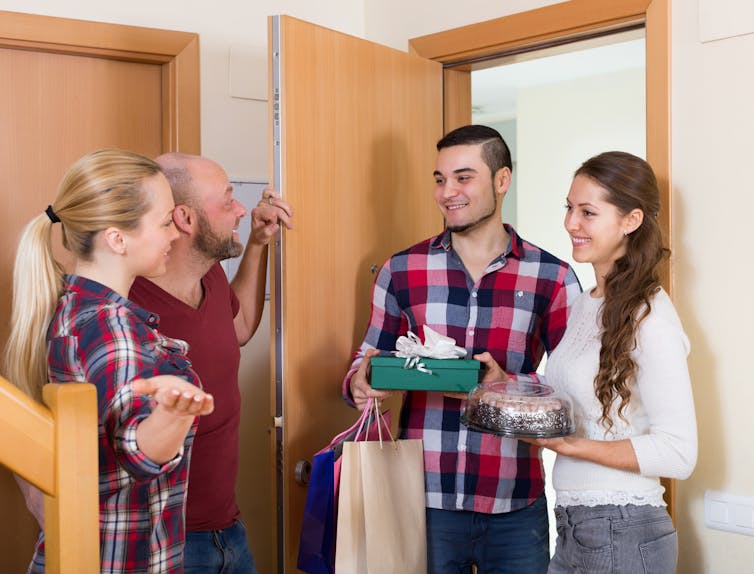Melburnians will soon be able to have 2 visitors per day. It's far riskier than an exclusive bubble
- Written by Mary-Louise McLaws, Professor of Epidemiology Healthcare Infection and Infectious Diseases Control, UNSW
Victorian Premier Daniel Andrews announced on Sunday a further easing of coronavirus restrictions, as Victoria’s 14-day average of new daily cases continues to trend downwards.
Among the changes, Melburnians were told that from November 2 they can have two visitors at home per day, plus any dependants. Regional Victorians can already enjoy this rule, as their 14-day rolling case average is much lower at 0.4, compared with Melbourne’s 6.4.
This new rule replaces the “bubble” concept featured in the original roadmap. Under the previous plan in Melbourne, “step 3” of easing restrictions included a household bubble, whereby residents could nominate one other household with whom to socialise exclusively at home.
I understand the lifting of restrictions must be done compassionately with an eye on collective mental health. But from an outbreak-management perspective we must be very careful about indoor gatherings. The two people per day rule seems to be riskier than an exclusive bubble.
The bubble contains the infection risk
The risk of indoor spread is often greater because of poor ventilation, which might add to the risk of airborne spread. Further, people can unmask and fail to maintain physical distancing, which are more likely to happen indoors.
Close indoor contact poses the highest risk of transmission of SARS-CoV-2, the virus that causes COVID-19. Victorian Chief Health Officer Brett Sutton reminds us indoor contact is about “20 times more dangerous than outdoors”. This is reflected in one study from Japan, which is yet to be peer-reviewed, and estimates “the odds that a primary case transmitted COVID-19 in a closed environment was 18.7 times greater compared to an open-air environment”.
Transmission still does occur outdoors, but the risk is lower.
The practice of exclusive social bubbles likely makes outbreaks easier to contain. The only people an infected person would have close indoor contact with would be their own household and their bubble household. In this scenario, contact tracers would know exactly whom to contact for isolation, testing and interviewing.
 Victorian Premier Daniel Andrews flagged that from November 2, Melburnians could have two adult visitors at home per day.
James Ross/AAP
Victorian Premier Daniel Andrews flagged that from November 2, Melburnians could have two adult visitors at home per day.
James Ross/AAP
Here’s why the new lifting of the social rule is riskier
The proposed new rule could make timely contact tracing more difficult. With Melburnians allowed to have two adults over per day, they could have up to 14 contacts per week who don’t come from the same household.
Let’s go through a hypothetical example.
Say you are exposed to the virus unknowingly, on day zero. Over the next few days you start having visitors to your house. You can become infectious up to three days before showing symptoms. When COVID-19 cases have been diagnosed while asymptomatic (symptom-free but infectious) and followed up for at least seven days, up to 20% remain asymptomatic but infectious to others. Half of all people infected will develop symptoms around day five and day six and 97% will develop symptoms within 11 days.
So, you could be infectious to your visitors between day three and day five after being exposed while asymptomatic. That leaves three days when you could be contagious without knowing. We think people are more contagious when showing symptoms, but it’s widely accepted now that people can, and do, transmit the virus while asymptomatic.
Under the upcoming rule, during this three-day window, you could theoretically pass the virus to six adults from six different households (assuming you’re an extrovert who has lots of friends round for dinner). They can then transmit it to their households and friends in three days’ time to 18 people while they are asymptomatic. If your friends also brought their children or other dependants, who then got infected and went to school, the number could be even higher. Under the exclusive bubble, the problem would have been confined to just two households.
Then, after your final two guests leave on the evening of day five post-infection, you develop symptoms. You get tested on day six because your cough or sore throat did not go away. Your positive result is returned on day seven and a contact tracer interviews you within 24 hours. On day eight your visitors will start to be interviewed. If they don’t get interviewed immediately, your friends infected on day three have now already infected two others. Over the next two days your other four friends also became infected and passed it onto their friends.
Obviously this is a worse case scenario. But you can see how the chain of transmission can easily get out of control. That’s why being tested as soon as you have symptoms is so important. It speeds up the tracing of every contact you had over the 72 hours prior to your symptoms.
 Indoor close contact is a much higher coronavirus risk than outdoor contact with masks.
Shutterstock
Indoor close contact is a much higher coronavirus risk than outdoor contact with masks.
Shutterstock
If we added to our scenario continuous asymptomatic transmission (where you never developed symptoms) it becomes even more concerning. This is because your infected friends could go on to infect many others before someone becomes sick and alerts contact tracers. Even more concerning is when you delay testing, which makes it even harder for you to recall who your contacts where and when your day zero was.
This is just a hypothetical situation. But it illustrates why I’m concerned about allowing widespread indoor close contact.
The hope is that new daily case numbers, by the time this rule is implemented, are so low the risk of new chains of transmission is very low too. Meanwhile, Victoria’s contact-tracing team is more robust than ever before.
Read more: Where did Victoria go so wrong with contact tracing and have they fixed it?
The other relaxed restrictions are less concerning
The other relaxed restrictions are of little concern. Allowing ten people to gather outdoors, from only two households, poses a negligible risk.
The extension of the 5km travel radius to 25km makes epidemiological sense. The risk increases when you allow people from high-risk areas into low-risk areas, so maintaining the “ring of steel” between metropolitan Melbourne and regional Victoria is logical. This approach of “ring-fencing” is a well-established tool and is why Wuhan, the city where the pandemic began, controlled the outbreak early and is now welcoming millions of tourists.
The next step, planned for November 2, also sees the return of retail shopping. This poses negligible risk as long as shoppers wear masks, maintain hand hygiene, and use QR codes on entry. In my view, the risk of transmission from wandering through shops is much lower than having people over to your house.
Authors: Mary-Louise McLaws, Professor of Epidemiology Healthcare Infection and Infectious Diseases Control, UNSW





